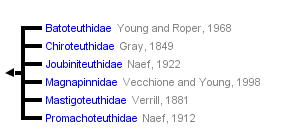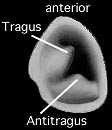Chiroteuthid families
Richard E. Young and Michael Vecchione


This tree diagram shows the relationships between several groups of organisms.
The root of the current tree connects the organisms featured in this tree to their containing group and the rest of the Tree of Life. The basal branching point in the tree represents the ancestor of the other groups in the tree. This ancestor diversified over time into several descendent subgroups, which are represented as internal nodes and terminal taxa to the right.

You can click on the root to travel down the Tree of Life all the way to the root of all Life, and you can click on the names of descendent subgroups to travel up the Tree of Life all the way to individual species.
For more information on ToL tree formatting, please see Interpreting the Tree or Classification. To learn more about phylogenetic trees, please visit our Phylogenetic Biology pages.
close boxIntroduction
Chiroteuthid families are a group of six families that share some similar features but whose inclusion as a monophyletic clade has not been firmly established. The most distinctive feature of the group is the loss of the true tentacle club and its replacement by a variety of unusual clubs that generally have more than four series of suckers.
Diagnosis
An oegopsid ...
- without primary tentacular club (possible exception in Planctoteuthis).
- with secondary tentacular clubs.
Characteristics
- Arms
- Suckers generally in two series (exceptions in Joubiniteuthidae and some Promachoteuthidae and Magnapinnidae).
- Buccal connectives attach to ventral borders of arms IV.
- Tentacles
- Primary club apparently lost except in Planctoteuthis; secondary clubs present and characterized by:
- Protective membranes on club approximately bilaterally symmetrical (ie, dorsal and ventral membranes similar) when present.
- Keel absent.
- Carpal-locking apparatus absent.
- Terminal pad absent.
- Club not expanded.
- Club straight.
- Funnel
- Locking-apparatus oval in most taxa but often with inward protruding knobs (tragus and antitragus) or other bumps making appearance highly variable.
 Click on an image to view larger version & data in a new window
Click on an image to view larger version & data in a new window
Figure. Ventral view of a funnel locking-apparatus of Chiroteuthis joubini. Drawing by A. Hart modified.
- Locking-apparatus oval in most taxa but often with inward protruding knobs (tragus and antitragus) or other bumps making appearance highly variable.
- Fins
- Fins usually terminal (more than 50% of fin length posterior to termination of muscular mantle).
- Tail
- A tail, often very long, and supported by the secondary conus of the gladius, generally present.
Comments
In the older doratopsid paralarvae of Chiroteuthis suckers develop on the tentacular stalk proximal to the tentacular club; during the transition to the juvenile/subadult stage, the doratopsid club either drops off or is resorbed leaving the distal stalk with its suckers to develop into the adult club (e.g., Naef, 1921-23). We assume that this sort of process is ancestral to the chiroteuthid families with the steps in the process still visible in the Chiroteuthidae. The fact that the doratapsid club in present in Planctoteuthis species is thought to indicate that these species are essentially mature paralarvae (Roper and Young, 1967).
A more complete description of the paralarval clubs in other chiroteuthid genera (Young, 1991) suggests that the primary doratopsid club has some of the characteristics of the basic oegopsid club. The primary doratopsid club has (1) suckers in four series (they diminish in number proximally and distally), (2) a club keel, and (3) an apparent terminal pad (distinct tip with a few suckers and a terminal cap). However, there is no clear division into manus and dactylus nor is there a carpal locking-apparatus although there is some modification of both distal (change in dentition) and proximal (change in relative diameter of acetabulum) suckers that could represent these structures. When these and other clubs are better understood, the primary doratopsid club could provide clues to the relationship of the chiroteuthid families to other oegopsids.
Discussion of Phylogenetic Relationships
The relationships among the families of this apparent clade are obscure with one exception. The Chiroteuthididae and Mastigoteuthididae have sometimes been placed within the same family due to similarities in the shape of the funnel locking-apparatus and the presence of elongate arms IV (e.g., Chun, 1910).
References
Chun, C. 1910. Die Cephalopoden. Oegopsida. Wissenschaftliche Ergebnisse der Deutschen Tiefsee-Expedition, "Valdivia" 1898-1899, 18: 1-522 + Atlas.
Title Illustrations

| Scientific Name | Batoteuthis scolops, Chiroteuthis veranyi, Joubiniteuthis portieri, Magnapinna pacifica, Mastigoteuthis glaukopis, Promachoteuthis megaptera |
|---|---|
| Acknowledgements | Batoteuthis scolops illustration by A. D. Hart, Chiroteuthis veranyi photograph copyright © 1996, E. McSweeny, Joubiniteuthis portieri photograph copyright © 1996, R. E. Young, Megapinna pacifica photograph copyright © 1998, Richard E. Young), Mastigoteuthis glaukopis from Chun, 1910, Promachoteuthis megaptera from Okutani, 1983. |
| Image Use |
 This media file is licensed under the Creative Commons Attribution-NonCommercial License - Version 3.0. This media file is licensed under the Creative Commons Attribution-NonCommercial License - Version 3.0.
|
| Copyright |
© 1996

|
About This Page

University of Hawaii, Honolulu, HI, USA

National Museum of Natural History, Washington, D. C. , USA
Page copyright © 2019
 Page: Tree of Life
Chiroteuthid families.
Authored by
Richard E. Young and Michael Vecchione.
The TEXT of this page is licensed under the
Creative Commons Attribution-NonCommercial License - Version 3.0. Note that images and other media
featured on this page are each governed by their own license, and they may or may not be available
for reuse. Click on an image or a media link to access the media data window, which provides the
relevant licensing information. For the general terms and conditions of ToL material reuse and
redistribution, please see the Tree of Life Copyright
Policies.
Page: Tree of Life
Chiroteuthid families.
Authored by
Richard E. Young and Michael Vecchione.
The TEXT of this page is licensed under the
Creative Commons Attribution-NonCommercial License - Version 3.0. Note that images and other media
featured on this page are each governed by their own license, and they may or may not be available
for reuse. Click on an image or a media link to access the media data window, which provides the
relevant licensing information. For the general terms and conditions of ToL material reuse and
redistribution, please see the Tree of Life Copyright
Policies.
- Content changed 26 March 2019
Citing this page:
Young, Richard E. and Michael Vecchione. 2019. Chiroteuthid families. Version 26 March 2019 (under construction). http://tolweb.org/Chiroteuthid_families/19410/2019.03.26 in The Tree of Life Web Project, http://tolweb.org/







 Go to quick links
Go to quick search
Go to navigation for this section of the ToL site
Go to detailed links for the ToL site
Go to quick links
Go to quick search
Go to navigation for this section of the ToL site
Go to detailed links for the ToL site